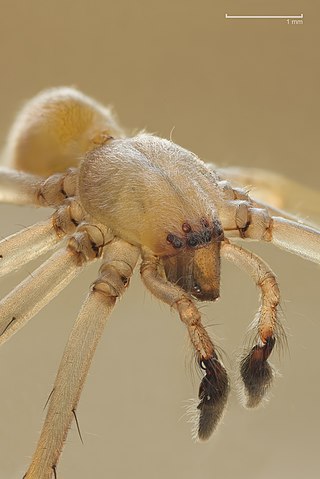
The Thomisidae are a family of spiders, including about 170 genera and over 2,100 species. The common name crab spider is often linked to species in this family, but is also applied loosely to many other families of spiders. Many members of this family are also known as flower spiders or flower crab spiders.

Henry Ogg Forbes was a Scottish explorer, ornithologist, and botanist. He also described a new species of spider, Thomisus decipiens.

Misumena vatia is a species of crab spider with a holarctic distribution. In North America, it is called the goldenrod crab spider or flower (crab) spider, as it is commonly found hunting in goldenrod sprays and milkweed plants. They are called crab spiders because of their unique ability to walk sideways as well as forwards and backwards. Both males and females of this species progress through several molts before reaching their adult sizes, though females must molt more to reach their larger size. Females can grow up to 10 mm (0.39 in) while males are quite small, reaching 5 mm (0.20 in) at most. Misumena vatia are usually yellow or white or a pattern of these two colors. They may also present with pale green or pink instead of yellow, again, in a pattern with white. They have the ability to change between these colors based on their surroundings through the molting process. They have a complex visual system, with eight eyes, that they rely on for prey capture and for their color-changing abilities. Sometimes, if Misumena vatia consumes colored prey, the spider itself will take on that color.

Runcinia is a genus of crab spiders that was first described by Eugène Louis Simon in 1875. The former R. elongata is a synonym of Thomisus elongatus.

The carunculated fruit dove is a species of bird in the family Columbidae. It is endemic to Obira.

Platythomisus is a genus of flattened crab spiders from Africa and Southern Asia.

Thomisus is a genus of crab spiders with around 142 species described. The genus includes species that vary widely in their ecology, with some that are ambush predators that feed on insects visiting flowers. Like several other genera in the family Thomisidae, they are sometimes referred to as flower crab spiders, from their crab-like motion and their way of holding their front legs, reminiscent of a crab spreading its claws as a threat.

Thomisus onustus is a crab spider belonging to the genus Thomisus. These spiders are found across Europe, North Africa, and parts of the Middle East and Asia. T. onustus reside in flowers in lowland vegetation. Females are distinguished by their larger size and ability to change color between white, yellow, and pink as a means of matching flower color. This cryptic mimicry allows them to both evade predators and enhance insect prey capture abilities. Males are smaller, more slender, and drab in coloration, usually green or brown. T. onustus is also distinguished from other relatives by its distinct life cycle patterns in which spiderlings emerge in either late summer or early spring. Furthermore, T. onustus have developed a mutualistic relationship with host plants where spiders feed on and/or deter harmful florivores while benefiting from the plant's supply of pollen and nectar, which T. onustus spiders are able to use as food sources, especially during periods of low insect prey abundance.

Dipogon variegatus is a pompilid spider wasp in the subfamily Pepsinae from the Palearctic.

Bassaniodes robustus is a ground crab spider species found from Europe to Central Asia.

The genus Oxytate, commonly known as grass crab spiders, comprises a homogenous group of nocturnal crab spiders. The complete mitochondrial genome of the type species O. striatipes was determined in 2014.

The two palpal bulbs – also known as palpal organs and genital bulbs – are the copulatory organs of a male spider. They are borne on the last segment of the pedipalps, giving the spider an appearance often described as like wearing boxing gloves. The palpal bulb does not actually produce sperm, being used only to transfer it to the female. Palpal bulbs are only fully developed in adult male spiders and are not completely visible until after the final moult. In the majority of species of spider, the bulbs have complex shapes and are important in identification.
T. spectabilis may refer to:
Thomisus callidus, the yellow crab spider, is a species of spider of the genus Thomisus. It is found in Sri Lanka, Singapore, Sumatra, Nias Island, and Java. They often hide in flowers and are able to change colors just to blend in to capture prey.
Ansiea is a genus of crab spiders that was first described by Pekka T. Lehtinen in 2004. This genus was named in honour of South African arachnologist Ansie Dippenaar-Schoeman. As of June 2020 it contains two species found in Africa and Saudi Arabia: A. buettikeri and A. tuckeri.

Thomisus spectabilis, also known as the white crab spider or Australian crab spider, is a small spider found in Australia and far east Asia.
Kryptochroma is a genus of South American bark-dwelling crab spiders erected by M. Machado, R. Viecelli, and C. Guzati in 2021 after a phylogenetic analysis showed that Stephanopis contained two distinctly different clades. The genus was created for the "pentacantha" clade, as well as for several newly described species.












